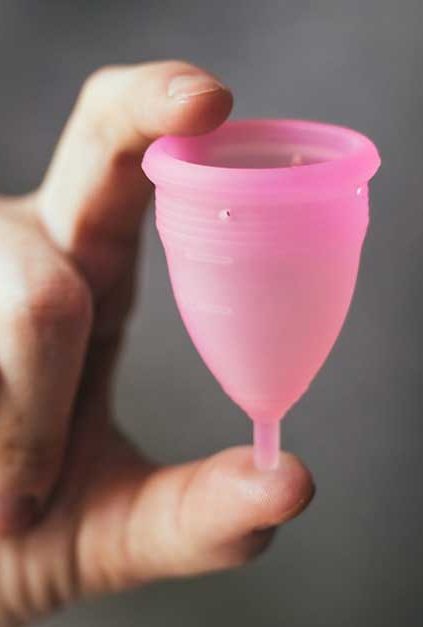What Is a Menstrual Cup?
It’s a reusable alternative to tampons and pads. A menstrual cup sits inside the vagina to collect the period blood that flows out. A few times a day, you pull it out (Careful! Don’t spill!) and pour the contents into the toilet. It’s washable, so you can use it cycle after cycle. One menstrual cup can replace years’ worth of disposable products.
If you’ve never seen a menstrual cup, imagine a silicone shot glass: that’s about the right size and feel. Except they’re usually curved at the bottom and have a little stem for a handle, so the shape is more like a cut-off wine glass.
Are Cups Safer Than Tampons?
You’re not running major risks with either one. We have a better sense of the risks of tampons than of cups, just because tampons are so popular and cups—though gaining in popularity—are still kind of underground. DivaCup, one of the biggest makers, has reportedly sold a million cups. That’s not a lot considering how many menstruating women must live in this country.
Most people who use the cups don’t have any problems, so as far as we can tell, they’re safe. There’s a myth, however, that cup users “can’t” develop toxic shock syndrome, or TSS, the disease that all the tampon packages are required to tell you about. This is false.
TSS is a serious and very rare infection that can lead to organ failure and death. Around 1980, it was associated with a brand of super duper absorbent tampons. Those were pulled from the market, and other manufacturers changed their formulations. The FDA required warnings about changing your tampon often. Cases plummeted, and TSS is now extremely rare again.
Last year, a study published in the Canadian Journal of Infectious Diseases and Medical Microbiology documented the first case of TSS associated with a menstrual cup. Obstetrician/gynecologist Dr. Jen Gunter writes, “We should now make no assumptions that cups are safer than tampons.” But both are still very safe.
There’s one other safety question: are cups a good way to avoid the chemicals in tampons? Critics point to dioxins, chemicals resulting from a bleaching process that used to be used in the making of tampons. But the FDA’s latest patient alert on the subject points out that makers are required to test for dioxins, and the tests haven’t been turning up any dioxins at detectable levels.
People who love their menstrual cups seem to feel the need to rail against “toxins” in pads and tampons, but there’s no realistic reason to fear the disposables. Those toxins are either obsolete like dioxins, imaginary like the urban legend about asbestos, or otherwise vague puffery like what you hear about in juice cleanses. Bottom line, neither cups nor tampons have any serious health risks that we know of.
Are Cups Better for the Environment?
Clearly, you generate less trash when you use a cup than when you’re going through a few dozen pads or tampons in a month. On the surface, that’s a win for the cup.
But let’s stop for a reality check: those products make up 0.5% of the garbage you produce over your lifetime. There’s enough guilt and shame surrounding periods without pretending your tampon habit is destroying the environment. Switching to a cup is a great way to reduce your garbage footprint, but you can make more of an impact by finding ways to reduce the other 99.5%.
Are Menstrual Cups Cheap?
Cups run $20-$40 each, depending on the brand. That’s a lot up front, but you’ll save over time if it means you’re not buying pads or tampons. (Quick calculation: if a multi pack of tampons is $7, and you buy a box every month, that’s $84/year. Obviously, prices and needs vary.)
Realistically, you might spend more. If the first cup doesn’t work out, you’ll be checking out comparison tools like this one to find a better model. Some women like to have a spare cup on hand, so that will double your costs. And while the cups don’t usually leak, nothing is foolproof—so you may still end up wearing a thin pad like a pantiliner as well.
You’ll also have to replace it, eventually. DivaCup suggests buying a new one annually. Mooncup says that their product lasts “for years and years.” The material will eventually break down, and your body may change over time, too. So the lifetime cost of using cups is more than the initial $30, but it’s still far less than using disposable products in the same timeframe.
Are Cups More Convenient?
This one is a toss-up, because convenience has many facets.
You (probably) don’t have to change cups as often. Cup devotees like to say they’re great for lazy people, since they can hold a ton of blood before you’re in any danger of leaking. Manufacturers aren’t required to put a warning on them saying how often to change them (the FDA wants you to change your tampon at least every eight hours), so cup makers often recommend a more generous 12 hours or so. Whether that’s a good idea or not, we really don’t know.
You (probably) don’t need to carry extra supplies with you all the time. If you suddenly realize you need to empty the cup, you just do it. If you like to wear backup pads, you’ll need those, of course. And you might want to carry wipes or a water bottle to clean the cup.
Emptying the cup can be annoying. If you’re in a restroom with stalls, it’s inconvenient to dump out the cup, pull up your pants, wash the cup in the sink, and then go back into the stall to reinsert. If you’re stuck somewhere with just a porta-potty, it’s the same situation minus the sink. In these cases, most manufacturers say you can dump the blood, wipe the cup with toilet paper, and pop it back in. You’re supposed to make sure to clean it for real as soon as you get a chance, but if you’re camping, that might not be possible. That’s where the wipes or water bottle come in: they’re ways to clean the cup when you don’t have access to a sink.
You also have to keep track of the cup when you’re not wearing it. If you’re used to always having tampons and pads in your purse, in your bathroom closet, in your car, in your gym bag, and everywhere else, it can be a little nerve-wracking to know that you only have one menstrual cup and you better know where it is. (Of course, you can still keep those pads and tampons around just in case.)
Some people even boil their cup between uses, although that’s probably not essential. If you want to sterilize it but don’t want to use your cooking pot, a microwave sterilizer bag made for baby bottles would probably do the trick. Check the instructions that came with your cup for specifics—for example, the Keeper’s material will break down sooner if you boil it often.
Source: vitals.lifehacker.com





